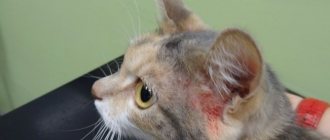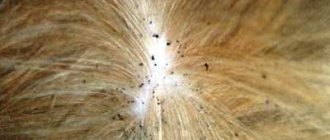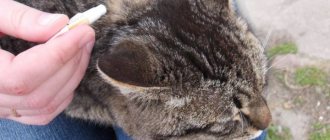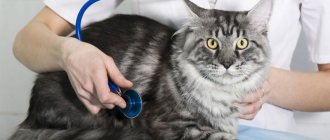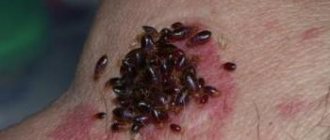- Why is my cat itching?
- Main symptoms
- Prevention
- What will the vet do?
Cat owners are well aware that their pets are prone to scratching behind their ears or licking their bellies.
They observe a similar picture several times a day and do not regard this behavior of the animal as abnormal. Indeed, cats love to wash themselves, but what to do if your pet itches very often for no apparent reason. If a cat constantly licks itself and the process of licking fur is accompanied by intense scratching of different parts of the body, then you should take a closer look at your pet. Perhaps the answer lies in simple things. The reason for this behavior of the animal can be several pathological conditions at once, which provoke the appearance of itching.
The cat itches, chews itself, constantly licks itself: is this normal?
If an animal itches due to severe itching, then with sharp claws it damages the skin, causing infection.
During severe itching, severe irritation of pain receptors occurs, because of this the animal begins to lick and chew itself. The skin on the affected area turns red and wounds appear. The reasons for this condition are different. To relieve the symptom and understand what to do, the pet must be shown to a doctor.
When it's ok
Cats are clean creatures. They wash themselves after sleep and after eating. If your pet eats natural food, then after licking the fur it will smell like the food it ate.
The smell of eaten herring is especially strong. If the animal licks itself too much, then it needs a medical examination.
Signs of a pathological condition of an animal
The painful condition can be determined by itching of the skin or ears. With skin itching, you can notice how the cat itches a lot and tries to bite the source of its anxiety from under the skin with its teeth.
When the itching is localized in the ear, the cat tries to stick its paw deep into it to scratch.
During this period you may notice:
- constant scratching of the body with a plaintive meow;
- pronounced biting of the skin;
- hair loss, deterioration of its appearance;
- the appearance of dandruff, oily scales;
- the skin is covered with ulcers or red rashes in the form of small spots;
- parasites or their excrement are visible on the skin.
It is easy to help an animal if you notice deviations in behavior in time and take him to the clinic. An advanced disease is more difficult to cure.
The influence of worms
Worms in a cat
The reason that the cat is itching, but there are no fleas, may be helminths. Intestinal parasites absorb beneficial substances and micronutrients from the intestines, which leads to the development of dryness and flaking of the skin, as well as the appearance of dandruff and itching. The animal's eyes become sour, stool is disrupted, appetite decreases, and the coat loses its shine and silkiness. The cat feels discomfort in the anus area. The pet constantly itches and licks itself, trying to get rid of unpleasant sensations.
Important!
Helminthiasis is especially dangerous for small kittens, as the consequence of this disease is anemia. In advanced cases, even the death of the baby is possible. Worm infestation is no less dangerous for a pregnant cat; it can cause miscarriage.
Therefore, if a cat or kitten is itching, you should urgently consult a veterinarian and find out how to treat your pet. Typically, the following drugs are used to deworm an animal:
- Kanikquantel;
- Panacur;
- Prazitel (for the treatment of kittens and cats);
- Febtal;
- Milbemax;
- Trontsil K and others.
Causes of itching in cats
It is easy to help an animal if you notice deviations in behavior in time and take him to the clinic.
A cat chews itself and itches when its skin itches.
There are several reasons that cause this condition:
- lichen;
- helminthiases;
- endocrine system problems;
- failure in the hormonal system;
- influence of stressful situations;
- the occurrence of skin diseases (fungus);
- there are insects in the fur that feed on blood;
- allergic reaction.
First, the animal is checked for fleas. This is the main reason why your pet starts to itch a lot. Flea bite marks persist for about 1.5 months, causing itching. If there are no insects in the animal's fur, it must be shown to a veterinarian.
Lice, lice, mites, flea dermatitis and other parasites that cause itching
Infection with ectoparasites occurs through outdoor shoes. The skin becomes inflamed if there are traces of scratches or small wounds on it.
Be sure to read:
Bald patches in a cat near the ears and above the eyes: reasons, what to do, how to distinguish normality from pathology
If they are not treated in time, the animal will scratch them. Suppuration will appear, which will lead to baldness or sepsis. Sulfur ointment or powder is used to treat wounds. The drug in powder form called Yuglone is the most effective and is recommended for use by veterinarians.
Infection with helminths as a cause of itching
Itching due to worms
If the animal is infected with worms, then:
- the pet itches and licks the anus area because it feels severe discomfort in this place;
- appetite deteriorates, stool changes, changes occur in the digestive tract;
- there are noticeable changes in the cat’s behavior (he is too excited or in an apathetic state);
- the skin is dry and flaky, and the coat becomes dull.
Important! Kittens also suffer from worms, having contracted them from their mother. As a preventive measure, animals should be regularly given a drug against helminth infection.
Hormonal and endocrine disorders
Major disorders of the hormonal and endocrine system:
- Improper functioning of the thyroid gland . At the same time, the fur becomes tangled, itching and dandruff appear. In some cases, cats go bald.
- Cushing's syndrome . Due to a malfunction of the adrenal cortex, the skin loses its elasticity and becomes thinner. Comedones appear on the back and sides of the animal.
- Diabetes . _ The disease manifests itself in the form of local baldness, dry skin, seborrhea, and dull hair.
Ringworm, fungi and other types of skin mycoses
If an animal is sick with ringworm (trichophytia), then treatment begins immediately.
Similar symptoms occur when the skin and fur of an animal are affected by fungal and yeast diseases. Dermatomycosis does not pose a danger to people; it is treated with antifungal drugs.
If an animal becomes ill with ringworm (trichophytia), then treatment begins immediately, since this disease can also affect humans. In the affected areas, hair falls out and bald patches appear in the form of circles. Therefore, areas that the animal scratches heavily should be carefully inspected.
Infectious skin diseases
Often itching and irritation are caused by infectious diseases:
- Cheyletiellosis ( pityriasis scabies) occurs due to infection by a separate group of mites of the genus Cheyletiella. Insects look like small white dots moving around. You can find them along the back.
- Pyodermatitis is caused by bacteria. They infect not only the surface of the skin, but also penetrate into the deep layers of the epidermis.
- Notoedrosis is a contagious infectious disease that occurs due to ticks. Itchy mange is transmitted through contact with a cat.
- Demodectic mange is a rare disease spread by ticks.
Ear parasites
Due to improper care, parasites appear in the animal’s ears. Ear mites (otodectes) infect the ear canal and cause severe itching.
An unpleasant odor emanates from the ears, which is accompanied by dark-colored discharge. In the affected areas, the skin becomes red, the animal constantly scratches its ears and shakes its head. Huge wounds appear behind the ears due to constant scratching.
Be sure to read:
Why does a cat constantly scratch its chin: what kind of disease is it?
Body temperature rises. The progression of the disease can lead to severe inflammation of the outer ear and parotid space. In such a situation, the cat tilts its head to the side and constantly walks in this position.
Skin diseases
Skin Diseases in Cats
Ringworm, as well as molds and yeasts, are another cause of an itchy cat. The presence of diseases in a pet may be indicated by the presence of dandruff and severe itching, the formation of clearly defined areas of hair loss and the appearance of wounds.
If a domestic cat has such a disease, there is a high probability of infection for the owner and his family members. Young children, whose immune systems are not yet fully developed, are especially at risk. Therefore, when in contact with a sick pet, we must not forget about observing the rules of hygiene.
On a note!
Itching and other symptoms of mycosis in a cat can be relieved with medications of the griseofulvin group. Treatment of the disease also involves vaccination and the use of antifungal drugs.
Treatment at home
Treatment at home includes taking medications and following a special diet.
Medicines for helminths
The drug is selected depending on the type of disease:
- Scabies from flea bites is treated with special drops and sprays. Anti-flea shampoos are used during bathing. Then a flea collar is put on the animal.
- Itching caused by fungal infections is eliminated with drugs from the griseofulvin group. The antifungal agent is applied externally. You can also get vaccinated.
- To get rid of ticks, acaricidal substances are used in the form of drops, sprays and shampoos. Drops against ear mites are instilled into the ears.
- To eliminate allergic reactions, it is necessary to remove the allergen from the diet and care products. For further treatment, antihistamines are used.
- Deworming medications help get rid of worms. During the examination, the doctor identifies what type of worms have affected the intestines and prescribes appropriate treatment.
- Dermatosis, otitis media and other infectious diseases are treated with antibiotics and anti-inflammatory drugs. To strengthen the immune system, the animal is prescribed vitamins A and B and immunostimulating drugs.
- Allergic dermatitis and ear scabies are treated with Stronghold. This drug is released in the form of drops that are applied to the animal’s neck. It also helps with flea bites.
Allergy
A cat does not always itch from fleas; an allergic reaction can also cause an itching sensation. It may be caused by changes in diet, the use of an anti-flea collar or an antiparasitic agent aimed at combating fleas, ticks and other bloodsuckers. A similar reaction of the body occurs to plant pollen, house dust, and also when using medications.
Only a veterinarian can determine the factors that can cause allergies in a cat, as well as the treatment method.
Veterinarian advice
Despite the risks of being outside, the cat needs fresh air, so you should not limit its freedom. Since infections and parasites are transmitted through hands or from other animals, preventative treatment against parasites should be carried out regularly.
Veterinarian advice:
- The animal must be kept clean.
- A good immune system will protect your cat from any infection. The key to health is proper and balanced nutrition.
- To prevent allergies, you should not include smoked and salty foods in your diet. Sweets are also prohibited.
- A change of owner or a sharp change in attitude towards a pet leads to stress and illness. A pet needs to be loved, cared for, and given enough attention.
The cat licks and itches, but there are no fleas
A signal about the development of the disease can be constant licking of fur, scratching and excessive attentiveness to one’s appearance. Often the cat owner thinks that the pet has fleas, but when examining the fur, it is clear that this is not the reason.
Possible causes of itching:
- allergy;
- fungal diseases;
- hormonal diseases;
- hypo- and vitamin deficiencies;
- change of diet.
Be sure to read:
Why does a cat bite and gnaw its tail strongly, sometimes until it bleeds? Should I be worried?
The cat licks itself vigorously and goes bald
Sometimes itching occurs for psychogenic reasons. Increased licking and scratching occurs when the animal is stressed. This is often observed when an individual requires mating. Taking sedatives will help calm your pet.
Cat licks after sterilization
Cats always try to lick wounds, sores and other skin lesions. After sterilization, a seam remains, which itches and itch, so the animal scratches and licks it. To prevent bleeding or other serious complications, a surgical collar is placed on the cat.
What to do if your cat is constantly licking
It can be difficult to diagnose why an animal constantly licks itself. First, the cat is checked for fleas, then it is analyzed whether the diet or care products have changed.
With a skin disease, the animal often shakes its head and licks itself until it bleeds. Only a doctor can diagnose the disease, so the pet must be taken to the clinic immediately. Based on the scrapings taken, they will be able to identify mites or fungal spores.
External parasites
External parasites in your pet
Not only flea attacks cause itching in a cat. In addition to fleas, other ectoparasites can also cause your pet to scratch frequently. So the culprit of otitis quite often becomes an ear mite that lives on the outside of the ear canal. The presence of such a bloodsucker is especially dangerous for pregnant cats.
The disease manifests itself as severe pain in the ear area, as well as the cat’s tendency to constantly scratch it. As a result, the pet is forced to endure great suffering, as wounds and bald patches appear in the affected area.
An itchy itch can also settle on the purr's head, the presence of which is accompanied by similar symptoms of itching. Only a veterinarian can detect a bloodsucker after conducting a microscopic examination of the skin.
Prevention of itching: does it exist at all, and what can be done?
Itching is caused by various factors, so following a number of prevention rules will help protect your cat from scratching:
- Poison worms in a timely manner. This will also help protect children who constantly play with animals. You should not give your cat raw foods: fish, meat.
- After each walk, inspect the animal for abrasions. Treat detected wounds with iodine or other disinfectants.
- To avoid infection with parasites, the cat should not be allowed to come into contact with other animals.
- Disinfect the cat litter box regularly.
- The transition to a new food should be carried out gradually.
- Do not punish your cat for minor offenses: this will prevent stress.
How to make a diagnosis?
To make an accurate diagnosis, the doctor conducts a medical history, a clinical examination of the animal, and diagnostic tests:
- Scraping and wet paper test;
- Cytological examination;
- Trichoscopy;
- Bacterial culture or mycological culture, etc.
It is not always possible to make a diagnosis at the first appointment, because diagnostic or trial treatments, diets, etc. may be required.
Diagnostics
A preliminary diagnosis can only be made based on the results of the examination, since the diseases have characteristic clinical signs described above. Additional studies are required to confirm the diagnosis. To exclude the presence of a bacterial or fungal infection, a cytological examination of skin smears is performed. Also, thanks to it, you can see the cells that appear in autoimmune diseases. Autoimmune disease is confirmed using skin histology. Using scrapings, in most cases it is possible to detect skin mites, but the Demodex gatoi mite is very rarely found in scrapings, and this disease is not easy to diagnose. Several methods can be used to diagnose lichen. First, the animal is examined under a fluorescent lamp - this method makes it possible to detect lichen in 50% of cases, since not all types of this infection will glow under the lamp. Then trichoscopy can be performed, thanks to which you can see the hairs destroyed by fungal spores. A more accurate diagnosis is to inoculate hairs in special growth media. Fungi in such environments can grow for a long time, up to 3-4 weeks, but the accuracy of this diagnosis is at least 95%.
Most often, identifying an allergen is not an easy task; there are no special tests for this. First, using scrapings, cultures, etc., it is necessary to exclude all possible differential diagnoses, which will be suggested by the doctor. If allergy remains the most likely diagnosis, the stage of excluding possible allergens will begin. First of all, fleas are excluded, the animal and the room where it lives are treated. A special elimination diet may then be prescribed to rule out food allergies. If the allergen is not identified, a diagnosis of “non-food allergy” or “atopy” is made.
Is this normal if fleas have nothing to do with it?
Because cats spend so much time keeping themselves clean, owners don't notice the problem coming. Cleanliness is not the only reason for washing cats. With its tongue, the cat evenly distributes the sebaceous secretion secreted by the skin.
When exposed to sunlight, it turns into vitamin D, making the coat soft and protecting the skin. Neatly laid fur provides the cat with the usual thermoregulation.
The cat is licking itself. Burning and itching of the skin becomes an alarm bell, the cat itches until it hurts and hair falls out along its back or belly. Excessive hair loss due to prolonged brushing is not normal. By scratching the skin with its rough tongue or sharp claws, a cat can cause an infection. Concomitant infection will increase licking, leading to a vicious cycle.
Important! If a cat endlessly scratches or licks the same area, it will cause acute moist dermatitis (hot spots), although dogs are more susceptible to this condition.
The usual culprit for scratching in cats is parasite bites, but why does a cat itch if it doesn't have fleas and ticks?
[custom_ads_shortcode1]



